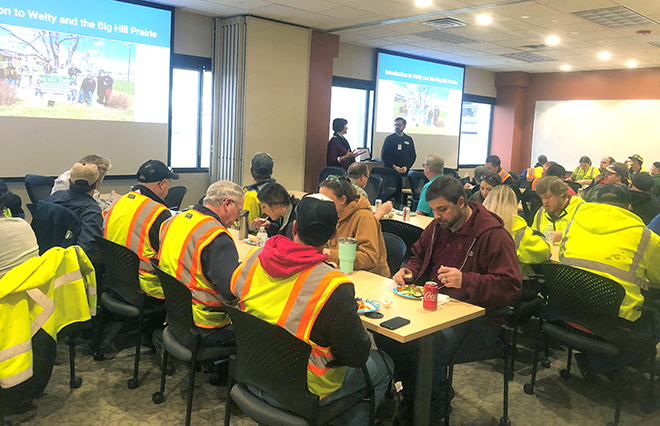Welty receives $10,000 CITF grant from DuPont

SUBMITTED PHOTO The Herald
Welty staff, Brenda Plakans, and Aaron Wilson, presented information on the Big Hill prairie restora-tion to DuPont employees over lunch on Nov. 20.
Friends of Welty Environmental Center received a $10,000 DuPont’s Clear Into the Future grant, to support prairie restoration work in Big Hill Park. Welty is using the funds to bring back goats to graze invasives in the summer and fall, pay for summer field trips, and cover other costs related to the restoration project.
Launched in 2007, Clear into the Future (CITF) is a DuPont initiative to protect and improve the natural environment through education and community engagement. The ClTF grant program seeks to provide funding to non-profit organizations for projects and initiatives that advance its purpose, specifically projects supporting climate change adaptation and mitigation, water stewardship, circular economy advancement, and ecosystem services in local DuPont communities around the globe.
Because of this support, Welty and their restoration partner, the Rock County Conservationists, will be able to finish restoring ten acres around the Center in 2020.
“This grant will help us focus on the area immediately adjacent to Big Hill Center, that we’ve been working on since 2017. A grant like this allows us to concentrate on the work itself, instead of having to figure out how to pay for it,” said Brenda Plakans, Welty Executive Director.
“We look forward to working with DuPont employees, whether they come to help clear brush on a work day or camp overnight with the goats. It’s beautiful out here, and it will be exciting to see our progress leap forward with help from the CITF grant.”
Welty received the grant, because their restoration work adresses all of the stated CITF goals. The Big Hill prairie habitat supports many species of native insects, animals, and plants–especially those that are slow to adapt to the changing climate.
The extensive root systems of native prairie plants secure the dirt and trap rainfall to prevent water and soil runoff.
As prairie plants repopulate the space, the currently depleted topsoil will begin to rebuild symbiotic microbial communities, which will contribute to plant health without additional chemical fertilizers.
The goats also contribute to soil health, as they fertilize the prairie with the resulting waste from their grazing efforts. This restoration will bring back a self-sustaining ecosystem that, once the major invasive removal is complete, will only require annual burning and minor brush and weed cutting instead of gasoline-powered tools to maintain its character.


